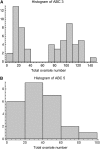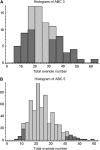The genetic basis of transgressive ovary size in honeybee workers
- PMID: 19620393
- PMCID: PMC2766328
- DOI: 10.1534/genetics.109.105452
The genetic basis of transgressive ovary size in honeybee workers
Abstract
Ovarioles are the functional unit of the female insect reproductive organs and the number of ovarioles per ovary strongly influences egg-laying rate and fecundity. Social evolution in the honeybee (Apis mellifera) has resulted in queens with 200-360 total ovarioles and workers with usually 20 or less. In addition, variation in ovariole number among workers relates to worker sensory tuning, foraging behavior, and the ability to lay unfertilized male-destined eggs. To study the genetic architecture of worker ovariole number, we performed a series of crosses between Africanized and European bees that differ in worker ovariole number. Unexpectedly, these crosses produced transgressive worker phenotypes with extreme ovariole numbers that were sensitive to the social environment. We used a new selective pooled DNA interval mapping approach with two Africanized backcrosses to identify quantitative trait loci (QTL) underlying the transgressive ovary phenotype. We identified one QTL on chromosome 11 and found some evidence for another QTL on chromosome 2. Both QTL regions contain plausible functional candidate genes. The ovariole number of foragers was correlated with the sugar concentration of collected nectar, supporting previous studies showing a link between worker physiology and foraging behavior. We discuss how the phenotype of extreme worker ovariole numbers and the underlying genetic factors we identified could be linked to the development of queen traits.
Figures










Similar articles
-
Support for the reproductive ground plan hypothesis of social evolution and major QTL for ovary traits of Africanized worker honey bees (Apis mellifera L.).BMC Evol Biol. 2011 Apr 13;11:95. doi: 10.1186/1471-2148-11-95. BMC Evol Biol. 2011. PMID: 21489230 Free PMC article.
-
Tyramine and its receptor TYR1 linked behavior QTL to reproductive physiology in honey bee workers (Apis mellifera).J Insect Physiol. 2020 Oct;126:104093. doi: 10.1016/j.jinsphys.2020.104093. Epub 2020 Aug 4. J Insect Physiol. 2020. PMID: 32763247
-
The dynamic association between ovariole loss and sterility in adult honeybee workers.Proc Biol Sci. 2017 Mar 29;284(1851):20162693. doi: 10.1098/rspb.2016.2693. Proc Biol Sci. 2017. PMID: 28356452 Free PMC article.
-
8. The development and evolution of division of labor and foraging specialization in a social insect (Apis mellifera L.).Curr Top Dev Biol. 2006;74:253-86. doi: 10.1016/S0070-2153(06)74008-X. Curr Top Dev Biol. 2006. PMID: 16860670 Free PMC article. Review.
-
Behavioral genomics of honeybee foraging and nest defense.Naturwissenschaften. 2007 Apr;94(4):247-67. doi: 10.1007/s00114-006-0183-1. Epub 2006 Dec 15. Naturwissenschaften. 2007. PMID: 17171388 Free PMC article. Review.
Cited by
-
Genetics of reproduction and regulation of honeybee (Apis mellifera L.) social behavior.Annu Rev Genet. 2012;46:97-119. doi: 10.1146/annurev-genet-110711-155610. Epub 2012 Aug 28. Annu Rev Genet. 2012. PMID: 22934646 Free PMC article.
-
The Architecture of the Pollen Hoarding Syndrome in Honey Bees: Implications for Understanding Social Evolution, Behavioral Syndromes, and Selective Breeding.Apidologie. 2014 May 1;45(3):364-374. doi: 10.1007/s13592-013-0244-3. Apidologie. 2014. PMID: 25506100 Free PMC article.
-
Integration of lncRNA-miRNA-mRNA reveals novel insights into oviposition regulation in honey bees.PeerJ. 2017 Oct 5;5:e3881. doi: 10.7717/peerj.3881. eCollection 2017. PeerJ. 2017. PMID: 29018616 Free PMC article.
-
Examining parent-of-origin effects on transcription and RNA methylation in mediating aggressive behavior in honey bees (Apis mellifera).BMC Genomics. 2023 Jun 12;24(1):315. doi: 10.1186/s12864-023-09411-4. BMC Genomics. 2023. PMID: 37308882 Free PMC article.
-
Genetic architecture of ovary size and asymmetry in European honeybee workers.Heredity (Edinb). 2011 May;106(5):894-903. doi: 10.1038/hdy.2010.138. Epub 2010 Nov 3. Heredity (Edinb). 2011. PMID: 21048673 Free PMC article.
References
-
- Allsopp, M. H., J. N. M. Calis and W. J. Boot, 2003. Differential feeding of worker larvae affects caste characters in the Cape honeybee, Apis mellifera capensis. Behav. Ecol. Sociobiol. 54: 555–561.
-
- Amdam, G. V., K. E. Ihle and R. E. Page, 2009. Regulation of honey bee (Apis mellifera) life histories by vitellogenin, in Hormones, Brain and Behavior, Ed 2, edited by S. Fahrbach. Elsevier, San Diego, CA (in press).
-
- Anderson, K. E., T. A. Linksvayer and C. R. Smith, 2008. The causes and consequences of genetic caste determination in ants (Hymenoptera: Formicidae). Myrmecol. News 11: 119–132.
Publication types
MeSH terms
Substances
Grants and funding
LinkOut - more resources
Full Text Sources

